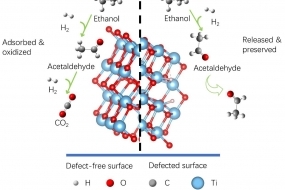Not all defects are bad! When Particles and Catalysis Research Laboratories started the research in photocatalysis many years ago we aimed for designing perfect crystals. We even used a phrase : “Kill the defects” as a strategy to make a good photocatalyst. Our recent publication recently published in Applied Catalysis B titled "Engineering defects in TiO2 for the simultaneous production of hydrogen and organic products" reveals defects can be beneficial.
We successfully achieved photoreforming of ethanol to simultaneously produce hydrogen and value-added organic products over defected TiO2. The chemically induced defects in TiO2 resulted in enhanced light absorption and charge separation, leading to improved overall photoactivity. These defects also regulated product selectivity, resulting in greater hydrogen purity and a higher liquid to gaseous carbon ratio.
Our study also revealed that the preferred ethanol oxidation pathway was direct hole transfer, indicating that selectivity relies on surface chemisorption. The DFT calculation confirms that surface defects decreased the acetaldehyde adsorption energy, leading to prompt desorption and suppressing overoxidation into CO2. This improved the selectivity towards hydrogen and liquid hydrocarbon products.
This research offers a promising alternative approach towards sustainable energy by coupling photocatalysis with waste organic utilisation.
The open access version of the article published in Applied Catalysis B: Environmental, is available online: https://doi.org/10.1016/j.apcatb.2023.122765
Meet our researcher and lead author: Jiajun Zhang

Graphical Abstract AppCat B vol 333 Sept 2023 - 122765